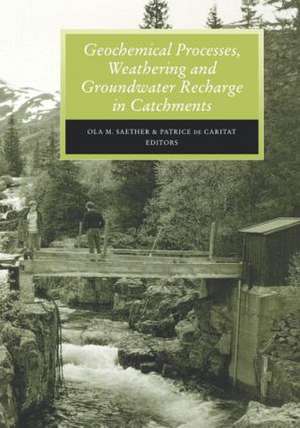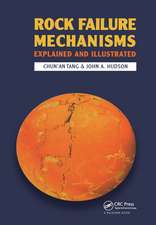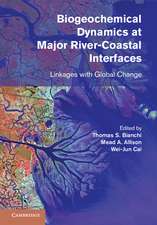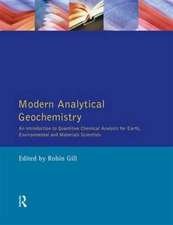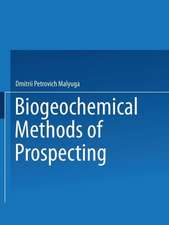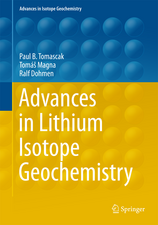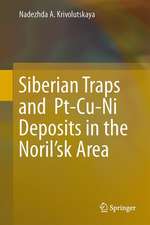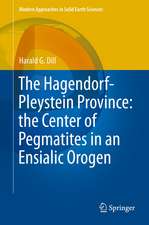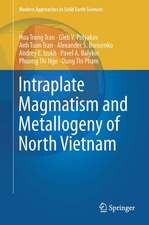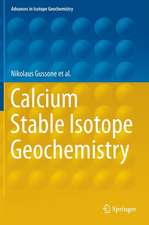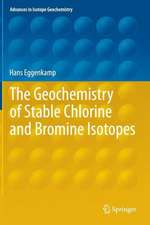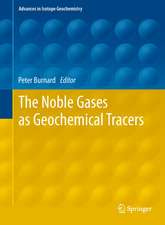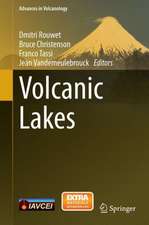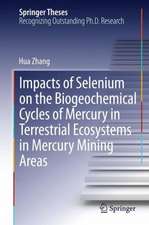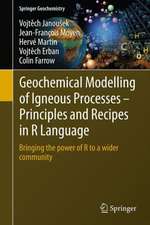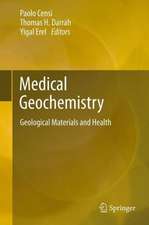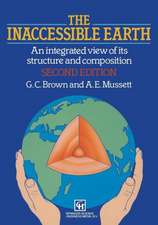Geochemical Processes, Weathering and Groundwater Recharge in Catchments
Autor O.M. Saether, P. de Caritaten Limba Engleză Hardback – 1996
.
Preț: 594.30 lei
Preț vechi: 699.17 lei
-15% Nou
Puncte Express: 891
Preț estimativ în valută:
113.72€ • 119.05$ • 94.09£
113.72€ • 119.05$ • 94.09£
Carte tipărită la comandă
Livrare economică 05-19 aprilie
Preluare comenzi: 021 569.72.76
Specificații
ISBN-13: 9789054106463
ISBN-10: 9054106468
Pagini: 414
Dimensiuni: 178 x 254 x 22 mm
Greutate: 0.7 kg
Ediția:Student
Editura: CRC Press
Colecția CRC Press
ISBN-10: 9054106468
Pagini: 414
Dimensiuni: 178 x 254 x 22 mm
Greutate: 0.7 kg
Ediția:Student
Editura: CRC Press
Colecția CRC Press
Cuprins
PREFACE -- PARTI: CATCHMENT PROCESSES -- 1 WEATHERING PROCESSES James I. Drever -- 1.1 Definitions of weathering -- 1.2 Types of weathering reaction -- 1.2.1 Congruent dissolution -- 1.2.2 Incongruent dissolution -- 1.3 Cation exchange -- 1.4 Mineral dissolution kinetics -- 1.4.1 Relative rates -- 1.4.2 Effects of solution composition on dissolution rates of silicate minerals -- 1.5 Comparisons between field and laboratory dissolution rates -- 1.6 Modeling approaches -- 1.7 Future research directions References -- 2 COMPOSITION, PROPERTIES AND DEVELOPMENT OF NORDIC SOILS Ole K Borggaard -- 2.1 Introduction -- 2.2 Soil composition -- 2.2.1 Soil air -- 2.2.2 Soil water -- 2.2.3 Soil organic matter (SOM) -- 2.2.4 Soil minerals -- 2.3 Soil properties -- 2.3.1 Physical properties -- 2.3.2 Chemical properties -- 2.4 Soil development processes -- 2.4.1 Decalcification -- 2.4.2 Gleization -- 2.4.3 Lessivage (clay migration) -- 2.4.4 Podzolization -- 2.5 Summary with conclusions -- 2.6 Future research directions -- Appendix A: Definition, terminology, horizons and description of soil -- Appendix B: Classification -- Acknowledgement -- References -- 3 CATCHMENT HYDROLOGY Allan Rodhe & Anund Killingtveit -- 3.1 Introduction -- 3.2 The catchment -- 3.3 Water balance -- 3.4 Runoff processes in the catchment -- 3.5 Soil water storage and flow processes -- 3.6 Mathematical modelling of soil water movement -- 3.6.1 Soil water potential -- 3.6.2 Water flow - Darcy’s law -- 3.6.3 Drainage equilibrium -- 3.7 Groundwater storage and flow -- 3.7.1 Aquifers and aquitards -- 3.7.2 Storage coefficient -- 3.7.3 Groundwater flow -- 3.7.4 Flow velocity -- 3.7.5 Preferential flowpaths - macropore flow -- 3.8 Streamflow generation -- 3.8.1 Hortonian overland flow -- 3.8.2 Variable source area -- 3.8.3 Recharge and discharge areas -- 3.8.4 Groundwater contribution in discharge areas -- 3.9 The role of topography -- 3.10 The HBV-model: A precipitation /runoff-model -- 3.10.1 The snow routine -- 3.10.2 The soil moisture routine -- 3.10.3 The runoff response routine -- 3.11 Model calibration and use -- 3.12 Components of the water budget in the Nordic countries References -- 4 GROUNDWATER RECHARGE David N Lemer -- 4.1 What is recharge? -- 4.1.1 Recharge and related concepts -- 4.1.2 Recharge in the hydrological cycle -- 4.1.3 Objectives of chapter -- 4.2 Hydrogeological environments -- 4.2.1 Introduction -- 4.2.2 Permo-Triassic sandstone of the UK -- 4.2.3 Scandinavian conditions -- 4.3 Precipitation recharge -- 4.3.1 Introduction -- 4.3.2 Lysimeters: Direct measurement -- 4.3.3 Empirical methods -- 4.3.4 Soil moisture budgeting method -- 4.3.5 Darcian approaches -- 4.3.6 Tracer techniques -- 4.3.7 Variability of recharge across catchments -- 4.3.8 Localised recharge -- 4.4 Recharge from rivers -- 4.4.1 River types -- 4.4.2 Rivers in contact with the water table -- 4.4.3 River recharge estimation methods -- 4.4.4 Groundwater response under ephemeral rivers -- 4.4.5 Water balances -- 4.4.6 Darcian approaches -- 4.4.7 Tracer techniques for groundwater recharge from river -- 4.5 Interaquifer flows -- 4.6 Net recharge over a region -- 4.6.1 Introduction -- 4.6.2 Water table rise -- 4.6.3 Hydrograph analysis for groundwater discharge -- 4.6.4 Inverse techniques -- 4.6.5 Aquifer-wide tracers -- 4.7 Concluding remarks -- References -- PART 2: TECHNIQUES FOR CATCHMENT STUDIES -- 5 CHEMICAL ANALYSIS OF ROCKS AND SOILS -- Magne 0degard -- 5.1 Introduction -- 5.2 Historical development -- 5.3 Total analysis versus partial analysis -- 5.4 Analytical methods -- 5.4.1 X-ray fluorescence (XRF) -- 5.4.2 Inductively coupled plasma atomic emission spectrometry (ICP-AES) -- 5.4.3 Atomic absorption spectrometry (AAS) -- 5.5 Quality control -- References -- 6 COLLECTION AND ANALYSIS OF GROUNDWATER SAMPLES John Mather -- 6.1 Introduction -- 6.2 Data quality -- 6.3 Sample collection and analysis -- 6.3.1 Field parameters -- 6.3.2 Laboratory measurements -- 6.3.3 Pore water analysis -- 6.4 Representation of data -- 6.5 Water quality standards -- Appendix A: Prescribed concentrations or values specified in the UK Water -- Supply (Water Quality) regulations 1989 -- References -- 7 ENVIRONMENTAL ISOTOPES AS TRACERS IN CATCHMENTS Sylvi Haldorsen, Gunnhild Riise, Berit Swensen & Ronald S. Sletten -- 7.1 Introduction -- 7.1.1 Environmental isotopes -- 7.1.2 The use of environmental isotopes in small catchments -- 7.2 Oxygen and hydrogen isotopes -- 7.2.1 Stable isotopes: 180 and 2H(D) -- 7.2.2 Application of 8180 and 8D in catchment studies -- 7.2.3 Tritium -- 7.3 Carbon isotopes -- 7.3.1 The 14C isotope -- 7.3.2 The 13C isotope -- 7.4 Nitrogen isotopes -- 7.4.1 Nitrogen isotope variations in precipitation -- 7.4.2 S15N of NO3 in the pedosphere and groundwater -- 7.4.3 Pollution studies in catchments and groundwater aquifers -- 7.5 Sulphur isotopes -- 7.5.1 Some examples of sulphur isotopes studies -- 7.6 Conclusions Acknowledgements References -- 8 FIELD INSTRUMENTATION -- Anund Killingtveit, Knut Sand & Nils Roar Scelthun -- 8.1 Streamflow measurements -- 8.1.1 Introduction -- 8.1.2 Measurement of stage -- 8.1.3 Discharge measurement methods -- 8.1.4 Stage-discharge relation -- 8.1.5 Practical considerations -- 8.2 Automatic data acquisition systems in hydrology -- 8.2.1 Introduction -- 8.2.2 Main structure and system components -- 9 CATCHMENT MASS BALANCE James I. Drever -- 9.1 Introduction -- 9.2 Terms in the mass balance equation -- 9.2.1 Solutes in outflow -- 9.2.2 Solutes from the atmosphere -- 9.2.3 Changes in the exchange pool -- 9.2.4 Changes in the biomass -- 9.2.5 Chemical weathering -- 9.3 Mass balance and mineral weathering -- 9.3.1 The Sierra Nevada, California, USA -- 9.3.2 Absaroka mountains, Wyoming, USA -- 9.3.3 Adirondack mountains, New York, USA -- 9.3.4 Sogndal, Norway -- 9.4 The problem of excess calcium -- 9.4.1 South Cascade Glacier, Washington, USA -- 9.4.2 Loch Vale, Colorado, USA -- 9.4.3 Discussion -- 9.5 Conclusions -- 9.6 Future directions in research References -- 10 NATURAL ORGANIC MATTER IN CATCHMENTS James F. Ranville & Donald L. Macalady -- 10.1 Introduction -- 10.2 The nature and origin of natural organic matter -- 10.2.1 Nature of natural organic matter -- 10.2.2 Origin of natural organic matter -- 10.3 Geochemical reactions of natural organic matter -- 10.3.1 Weathering and natural organic matter in catchments -- 10.3.2 Development of natural organic matter profiles in catchments -- 10.3.3 Hydrological controls on the transport of natural organic matter -- 10.3.4 Redox chemistry of metal-organic complexes -- 10.3.5 Natural organic matter and metal ion transport -- 10.4 Interactions between natural organic matter and anthropogenic chemicals -- 10.4.1 Transport of pollutant metals as dissolved natural organic matter complexes -- 10.4.2 Effects of sorption /partitioning to natural organic matter on the transport of organic chemicals -- 10.4.3 Effects of natural organic matter on hydrolytic reactions -- 10.4.4 Oxidation /reduction reactions facilitated by natural organic matter -- 10.4.5 Colloidal natural organic matter and facilitated transport -- 10.4.6 Natural organic matter... sink for pollutants or facilitator of transport? Mysteries and research questions -- 10.5 Conclusions -- 10.6 Future research directions -- References -- 11 RELATIONSHIP BETWEEN ROCK, SOIL AND GROUNDWATER COMPOSITIONS John Mather -- 11.1 Introduction -- 11.2 The source term -- 11.3 Factors affecting groundwater chemistry -- 11.4 Reactions in the unsaturated zone -- 11.4.1 Gas dissolution and redistribution -- 11.4.2 Carbonate and silicate dissolution -- 11.4.3 Sulphide oxidation -- 11.4.4 Gypsum precipitation and dissolution -- 11.4.5 Cation exchange -- 11.4.6 Organic reactions -- 11.5 Reactions in the saturated zone -- 11.5.1 Carbonate and silicate dissolution -- 11.5.2 Dissolution of soluble salts -- 11.5.3 Redox reactions -- 11.5.4 Cation exchange -- 11.6 Saline groundwaters -- 11.7 Groundwater compositions -- 11.8 Anthropogenic influences -- 11.8.1 Agricultural pollution -- 11.8.2 Industrial pollution -- 11.8.3 Acid rain -- 11.9 Conclusions -- 11.10 Future research -- References -- 12 TOWARDS COUPLING HYDROLOGICAL, SOIL AND WEATHERING PROCESSES WITHIN A MODELLING PERSPECTIVE Colin Nealy Alice J. Robson & Nils Christophersen -- 12.1 Introduction -- 12.1.1 General -- 12.2 A case study from Wales -- 12.2.1 Description of the study area -- 12.2.2 Hydrochemistry -- 12.3 Sources contributing to stream flow -- 12.3.1 Rationale -- 12.3.2 Hydrograph separation -- 12.3.3 Hydrograph separation using continuous data -- 12.3.4 Conclusions concerning water mixing relationships -- 12.4 Chemical mixing, speciation and solubility controls for aluminium -- 12.4.1 Rationale -- 12.4.2 Modelling chemical speciation -- 12.4.3 Mixing model results -- 12.5 Modelling studies -- 12.5.1 Modelling background -- 12.5.2 Short term modelling studies -- 12.5.3 Long term modelling studies -- 12.6 Towards integrated models -- 12.6.1 Developing a cation exchange model accounting for soil heterogeneity -- 12.6.2 Summary of findings -- 12.7 Discussions -- 12.8 Recommendations -- 12.9 Conclusions -- 12.10 Future research directions -- References -- 13 CHEMICAL CHANGES ATTENDING WATER CYCLING THROUGH -- A CATCHMENT - AN OVERVIEW -- Patrice de Caritat & Ola M. Saether -- 13.1 Introduction -- 13.2 The geochemical cycle -- 13.3 The water cycle -- 13.4 Every drop of rain -- 13.5 Soil searching -- 13.6 The water table -- 13.7 Discharge! -- 13.8 All the rivers run -- Acknowledgements -- A non-comprehensive list of useful references -- LIST OF AUTHORS -- INDEX.
Notă biografică
Dr Ola M Saether and Patrice de Caritat are senior research scientists at the Geochemistry and Hydrogeology Section of the Geological Survey of Norway.
Descriere
This volume covers areas such as: introduction to weathering processes; catchment hydrology; chemical analysis of rocks and soils; collection and analysis of groundwater samples; environmental isotopes as tracers in catchment; and field instrument...
